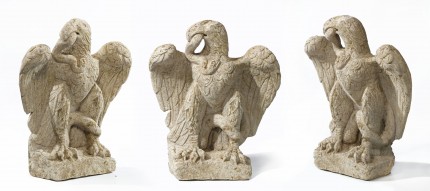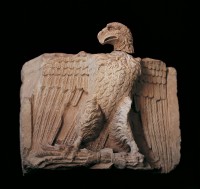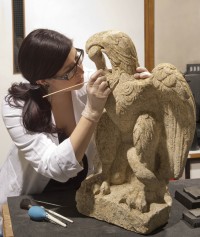
Museum of London archaeologists excavating Minories, a street near the Tower of London, before construction of a hotel on the site have unearthed a spectacular Roman-era sculpture of an eagle biting a serpent. The discovery was made six weeks ago in the last few hours of the last day of a 10-week excavation, but the piece is in such fine condition that the museum refrained from announcing the find at first because even though it looked Roman, its exquisite preservation made the archaeologists who found it suspect that it might be a Victorian garden ornament. Several experts have examined the eagle now and all confirm that it is a Romano-British sculpture from the 1st or 2nd century A.D.
Carved out of oolitic limestone from the Cotswolds, the sculpture is more than two feet tall and 1’10” wide. It depicts an eagle with wings spread biting a snake coiled around the bird, its forked tongue protruding. Other than a small piece missing from the broken right wing (the wing hasn’t been reattached; it’s on a custom frame that keeps it in place), the sculpture is complete with every detail from feathers to talons still sharp. It may have been painted originally but so far no trace of paint has been found on the surface.
The symbolism is understood as the struggle of good, the eagle, against evil, the snake. This theme is common in funerary contexts and an important Roman cemetery is known to have been located on the site. It is believed by archaeologists that this statue once adorned a rich mausoleum, the foundations of which were also uncovered during excavation. The lack of weathering on the statue corroborates this theory, as does the absence of detail on the back of the sculpture; suggesting it once sat it an alcove.
 Although the eagle vs. snake imagery is widespread in the Roman world, the only other freestanding Roman sculpture known to have survived comparable with this one was found in the great Nabatean city of Petra, in what is today Jordan, and is now part of the permanent collection of the Cincinnati Art Museum. I couldn’t find any pictures of it, sadly, other than a little thumbnail in the Daily Mail article about the discovery. You can see that it’s far from complete, with the beak and chest of eagle missing. The picture on the right is of another eagle from 1st century Petra, a relief, that is now in the Cincinnati Art Museum’s collection.
Although the eagle vs. snake imagery is widespread in the Roman world, the only other freestanding Roman sculpture known to have survived comparable with this one was found in the great Nabatean city of Petra, in what is today Jordan, and is now part of the permanent collection of the Cincinnati Art Museum. I couldn’t find any pictures of it, sadly, other than a little thumbnail in the Daily Mail article about the discovery. You can see that it’s far from complete, with the beak and chest of eagle missing. The picture on the right is of another eagle from 1st century Petra, a relief, that is now in the Cincinnati Art Museum’s collection.
Petra was a major center of trade thanks to its prime location at the crossroads of Middle Eastern caravan routes and the Nabatean’s extraordinary water control systems. It’s a testament to the skill of the Romano-British sculptors that Britannia could produce art of at least equal quality as is found Petra. The Cotswolds is known to have been a center of Roman sculpture, although the sculptures that survive have primarily been small or fragments of larger pieces. Most of the sculptures found have been in the Cotswolds area as the Jurassic vein of oolitic limestone of the Cotswold hills was the source of the stone and sculptors mainly worked on the spot. They did travel, however, to large cities, either bringing the raw stone with them or completing the sculpture at home and then transporting the finished work to its destination. The family of the deceased was clearly willing to pay a pretty penny for a top quality funerary sculpture from the best artists in the province.
 The eagle’s rough surface is the natural finish of Cotswolds limestone which is coarse enough that fine details are sometimes hard to convey in this medium. It is, however, an ideal material from the sculptor’s perspective because it’s soft to carve but over time hardens leaving a durable surface, durable enough to survive centuries underneath a burgeoning metropolis. Of course the find spot was outside the city in Roman times, like all cemeteries, but as London grew, Minories was absorbed into the urbs and the tombs that once lined the street were destroyed to make way for new construction. Their materials, including decorative elements, were recycled, used as masonry and fill, which is why we know very little about the Roman cemetery.
The eagle’s rough surface is the natural finish of Cotswolds limestone which is coarse enough that fine details are sometimes hard to convey in this medium. It is, however, an ideal material from the sculptor’s perspective because it’s soft to carve but over time hardens leaving a durable surface, durable enough to survive centuries underneath a burgeoning metropolis. Of course the find spot was outside the city in Roman times, like all cemeteries, but as London grew, Minories was absorbed into the urbs and the tombs that once lined the street were destroyed to make way for new construction. Their materials, including decorative elements, were recycled, used as masonry and fill, which is why we know very little about the Roman cemetery.
Michael Marshall, MOLA Finds Specialist, said: “The eagle is a classically Roman symbol and this new find provides a fascinating new insight into the inhabitants of Roman London and demonstrates their familiarity with the iconography of the wider classical world. Funerary sculpture from the city is very rare and this example, perhaps from inside a mausoleum, is a particularly fine example which will help us to understand how the cemeteries and tombs that lined the roads out of the city were furnished and the beliefs of those buried there.”
Starting today, the eagle and snake are on display in the Museum of London’s Roman London gallery. It will remain on public view for six months after which it will be removed for further study.
Awesome post about Roman sculpture.
Serpent always meant healing and still does. When men overthrew women, they corrupted the healing serpent into evil, as he did all her sacred symbols of health. Can’t build a patriarch without hating women and everything good she stood for, including the snake, dragon … basically anything you see men killing.
Very nice post sir i am your fan. i read your written post everyday.